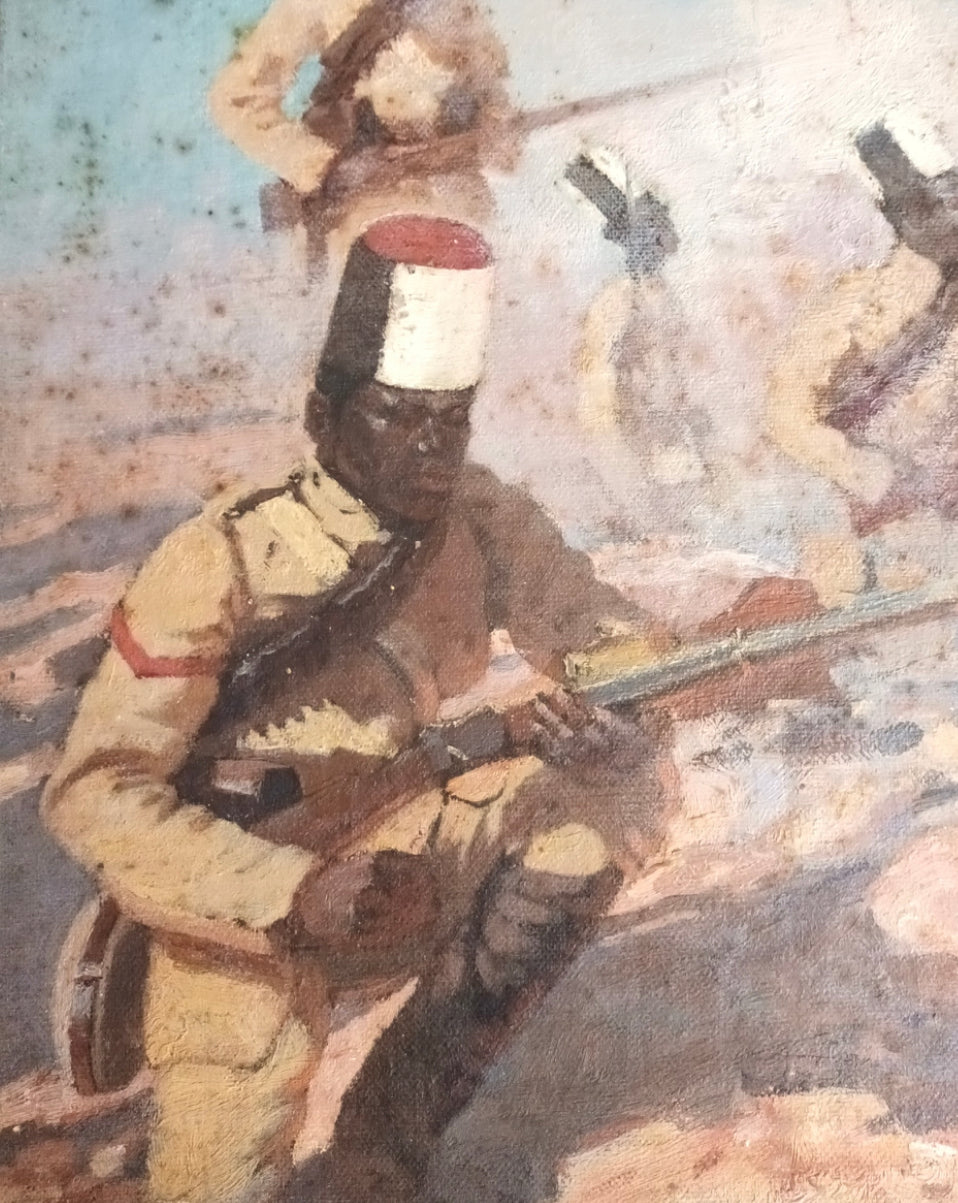Vereker Monteith Hamilton Scottish b. 1856, African Solidiers WW1
Regular price
£500.00 GBP
Regular price
Sale price
£500.00 GBP
Unit price
per
Tax included.
Couldn't load pickup availability
African Soldiers in an unknown WW1 skirmish.
Oil on Board by Vereker Monteith Hamilton 1856 -1931
Size – 36 x 27cm
This is one of a number of works by this artist we have recently acquired
Vereker Monteith Hamilton 1856 – 1931 was a Scottish artist of military and historical works.
He was born in Hafton, Argyll a son of Lieut. Col. Christian Monteith Hamilton of the 92nd Highlanders, and brother of British general Sir Ian Standish Monteith Hamilton. His mother Corinna Vereker, daughter of John Vereker, 3rd Viscount Gort, died when he was born. He followed his brother to Wellington College in 1871–73, and was destined for the army, and travelled to Dresden in 1873 to spend time with Colonel Drammers. However, he chose a career in art instead, following several years in Ceylon from 1873 to 1883 where he grew coffee. He studied art under Alphonse Legros at the Slade School where he won a prize in 1886 for landscape painting. He exhibited at the Royal Academy from 1886 onwards and at the Paris Salon, Glasgow and at the Grosvenor Gallery. He travelled to India in 1886 and spent a good deal of time there visiting Simla and Kashmir. In late 1893 he was living in Kilberry, Tarbert, Argyllshire.
Hamilton's military works focused primarily on contemporary events such as Piper Findlater at Dargai and the Tirah campaigns. He exhibited two paintings of the latter campaign entitled Missing and Afridis. His painting of Peiwar Kotal was inspired by a conversation with Lord Roberts who encouraged Hamilton to paint the scene. Another picture from the Second Afghan War depicted The 92nd at Kandahar, but he considered it a "shocking bit of work", and after its exhibition at the Royal Academy, repainted it with a number of new figures; it was exhibited again under its new title Macpherson's Brigade at Kandahar. In 1899, he returned to the subject with his Royal Academy piece Sniping the rear guard. During the First World War, the artist who was a conscientious objector served with the British Red Cross, although he did paint a number of paintings of the war at this time.
Oil on Board by Vereker Monteith Hamilton 1856 -1931
Size – 36 x 27cm
This is one of a number of works by this artist we have recently acquired
Vereker Monteith Hamilton 1856 – 1931 was a Scottish artist of military and historical works.
He was born in Hafton, Argyll a son of Lieut. Col. Christian Monteith Hamilton of the 92nd Highlanders, and brother of British general Sir Ian Standish Monteith Hamilton. His mother Corinna Vereker, daughter of John Vereker, 3rd Viscount Gort, died when he was born. He followed his brother to Wellington College in 1871–73, and was destined for the army, and travelled to Dresden in 1873 to spend time with Colonel Drammers. However, he chose a career in art instead, following several years in Ceylon from 1873 to 1883 where he grew coffee. He studied art under Alphonse Legros at the Slade School where he won a prize in 1886 for landscape painting. He exhibited at the Royal Academy from 1886 onwards and at the Paris Salon, Glasgow and at the Grosvenor Gallery. He travelled to India in 1886 and spent a good deal of time there visiting Simla and Kashmir. In late 1893 he was living in Kilberry, Tarbert, Argyllshire.
Hamilton's military works focused primarily on contemporary events such as Piper Findlater at Dargai and the Tirah campaigns. He exhibited two paintings of the latter campaign entitled Missing and Afridis. His painting of Peiwar Kotal was inspired by a conversation with Lord Roberts who encouraged Hamilton to paint the scene. Another picture from the Second Afghan War depicted The 92nd at Kandahar, but he considered it a "shocking bit of work", and after its exhibition at the Royal Academy, repainted it with a number of new figures; it was exhibited again under its new title Macpherson's Brigade at Kandahar. In 1899, he returned to the subject with his Royal Academy piece Sniping the rear guard. During the First World War, the artist who was a conscientious objector served with the British Red Cross, although he did paint a number of paintings of the war at this time.




